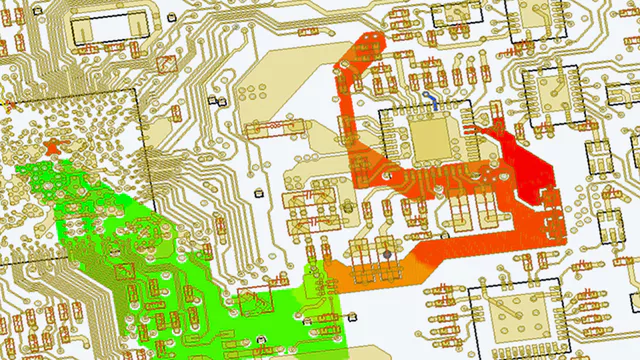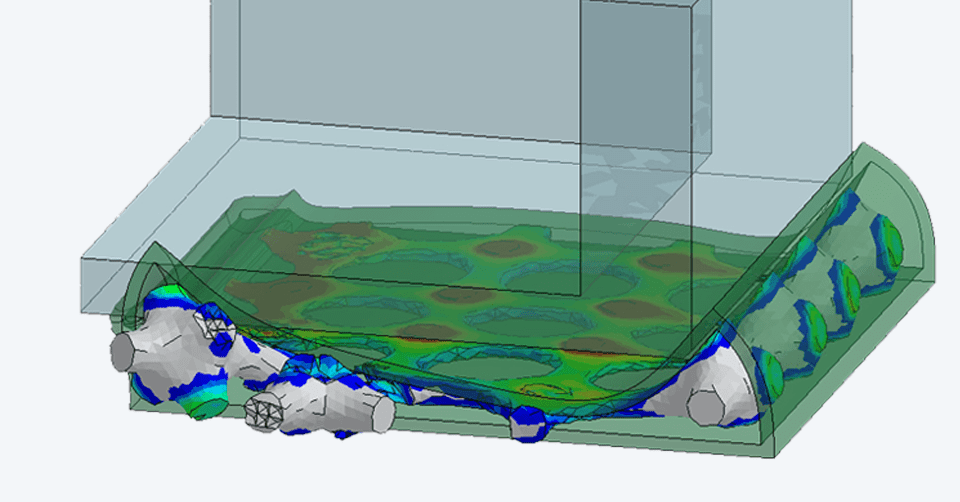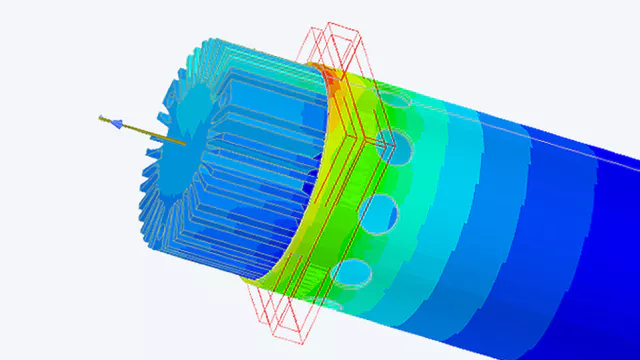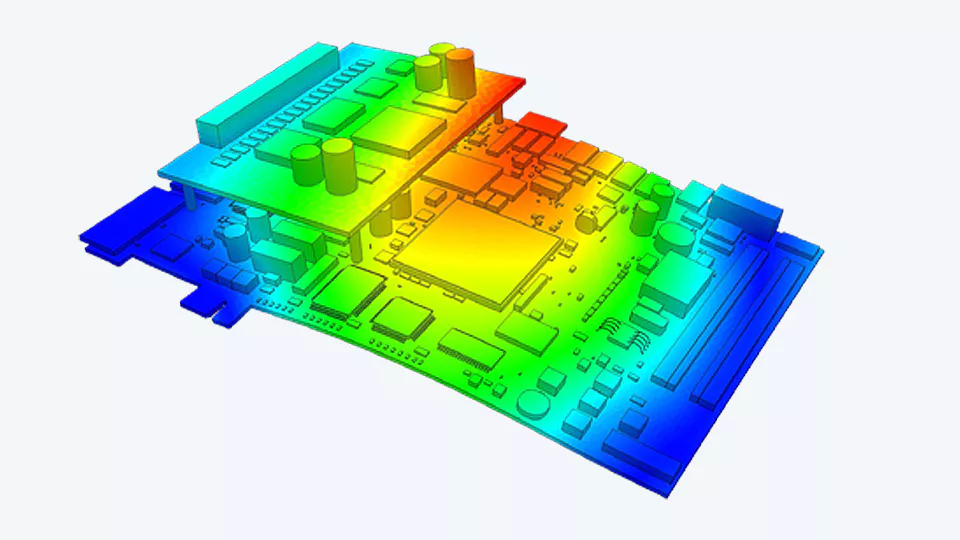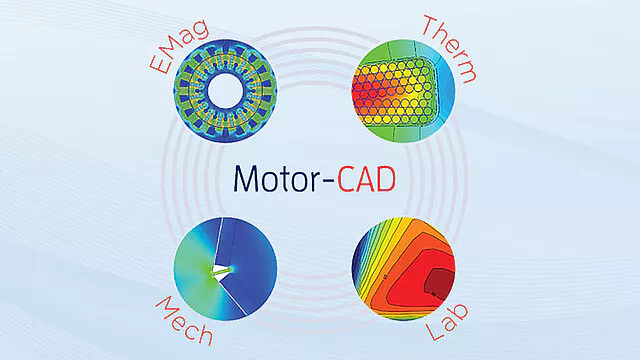Ansys for Electronics Simulation
Ansys for Electronics Simulation
Complete Electronics Simulation Solutions with Ansys

The suite of Ansys Electronics solutions allows you to minimize testing costs, ensure regulatory compliance, and improve reliability while significantly reducing product development time.
Our reference simulators are designed to address the most critical aspects of your product design. Whether you’re working on electric machines, electric vehicle powertrains, printed circuit boards, enclosures, integrated circuit designs, antennas, RF devices, microwaves, or electromechanical systems, Ansys solutions help you tackle challenges in electromagnetics, thermal management, signal integrity (SI), power integrity (PI), crosstalk, wiring, and vibration.
Use our advanced simulation capabilities to efficiently and effectively build the best-in-class cutting-edge products.
Complete Electronics Simulation Solutions with Ansys

The suite of Ansys Electronics solutions allows you to minimize testing costs, ensure regulatory compliance, and improve reliability while significantly reducing product development time.
Our reference simulators are designed to address the most critical aspects of your product design. Whether you’re working on electric machines, electric vehicle powertrains, printed circuit boards, enclosures, integrated circuit designs, antennas, RF devices, microwaves, or electromechanical systems, Ansys solutions help you tackle challenges in electromagnetics, thermal management, signal integrity (SI), power integrity (PI), crosstalk, wiring, and vibration.
Use our advanced simulation capabilities to efficiently and effectively build the best-in-class cutting-edge products.
Discover the flagship product: Ansys HFSS!
3D Simulation of High-Frequency Electromagnetic Phenomena
Ansys HFSS is a 3D electromagnetic simulation software that allows for the design and simulation of high-frequency electronic products such as antennas, antenna arrays, RF or microwave components, high-speed interconnects, filters, connectors, integrated circuit enclosures, and printed circuit boards.
Engineers around the world use Ansys HFSS software to design high-frequency and high-speed electronic components used in communication systems, advanced driver-assistance systems (ADAS), satellites, and Internet of Things (IoT) products.

Discover the flagship product: Ansys HFSS!
3D Simulation of High-Frequency Electromagnetic Phenomena
Ansys HFSS is a 3D electromagnetic simulation software that allows for the design and simulation of high-frequency electronic products such as antennas, antenna arrays, RF or microwave components, high-speed interconnects, filters, connectors, integrated circuit enclosures, and printed circuit boards.
Engineers around the world use Ansys HFSS software to design high-frequency and high-speed electronic components used in communication systems, advanced driver-assistance systems (ADAS), satellites, and Internet of Things (IoT) products.

HIGHLIGHTS
HFSS is the leading EM tool for R&D and virtual prototyping. It reduces the design cycle time and enhances the reliability and performance of your product.

Analyse EMI/EMC
Ansys Electronics Desktop allows engineers to easily combine the unmatched precision of Ansys’ 3D and 2.5D electromagnetic field solvers with the powerful circuit and system-level solutions of Ansys RF Option, enabling them to diagnose, isolate, and eliminate EMI and RFI issues early in the design cycle.
Users can leverage the seamless workflow of Electronics Desktop, which includes advanced electromagnetic field solvers, and dynamically link them to power circuit simulators to predict the EMI/EMC performance of electrical devices. These integrated workflows eliminate the need for repetitive design iterations and costly EMC certification testing. Multiple EM solvers designed to address various electromagnetic issues, along with the circuit simulators in Electronics Desktop, help engineers evaluate the overall performance of their electrical devices and create interference-free designs. These issues range from radiated and conducted emissions, susceptibility, crosstalk, RF detection, RF coexistence, co-site, electrostatic discharge, electrical fast transients (EFT), lightning effects, high-intensity radiated fields (HIRF), radiation hazards (RADHAZ), electromagnetic environmental effects (EEE), electromagnetic pulses (EMP), to shielding effectiveness and other EMC applications.
Radio Frequency Interference (RFI) in Complex Environments
EMIT works hand in hand with Ansys HFSS to combine RF system interference analysis with the best electromagnetic simulation for antenna-antenna coupling modeling. This results in a comprehensive solution that reliably predicts the effects of radio frequency interference (RFI) in multi-antenna environments with multiple transmitters and receivers.
The powerful analysis engine of EMIT calculates all important RF interactions, including the nonlinear effects of system components. Diagnosing radio frequency interference (RFI) in complex environments is notoriously difficult and expensive to perform in a test environment, but thanks to EMIT’s dynamic linked result views, identifying the root cause of any interference is quickly done through graphical signal tracing and diagnostic summaries that show the exact origin and path that interference signals take to reach each receiver. Once the cause of the interference is discovered, EMIT allows for the rapid evaluation of different interference mitigation measures to find the optimal solution.
The new HFSS/EMIT data link enables the creation of the RFI analysis model in EMIT directly from the 3D physical model of the installed antennas in HFSS. This enables a seamless end-to-end workflow for a complete RFI solution for RF environments, ranging from cosite interference in large platforms to receiver desensitization in electronic devices.
Analysis of Installed Antennas and RF Sites
In Ansys HFSS, engineers can simulate both infinite and finite phased array antennas, accounting for all electromagnetic effects, including mutual coupling, network definition, finite array edge effects, fictitious elements, and element removal, through advanced unit cell simulation.
A candidate network design can examine the input impedances of all elements in any beam scanning condition. Phased array antennas can be optimized in terms of performance at the element, sub-array, or full network level based on element matching (passive or driven) and the far-field and near-field pattern behavior in any scanning condition of interest. Modeling an infinite array involves one or more antenna elements placed in a unit cell. The cell contains periodic boundary conditions on the surrounding walls to reflect the fields, thereby creating an infinite number of elements. The scanning impedance of the elements and the radiation patterns of the integrated elements can be calculated, including all mutual coupling effects. This method is particularly useful for predicting blind scanning angles that may occur under certain beam orientation conditions. The finite array simulation technology relies on domain decomposition with the unit cell to achieve a fast solution for large finite-sized arrays. This technology enables a comprehensive network analysis to predict all mutual couplings, scanning impedance, element models, array models, and array edge effects.
RF Systems and Circuit Analysis
Combined with HFSS, RF circuit and system simulation technologies create a high-performance end-to-end workflow for RF applications, EMI/EMC, and more.
It includes EMIT, a unique multifidelity approach to predict the performance of RF systems in complex RF environments with multiple sources of interference. EMIT also provides the necessary diagnostic tools to quickly identify the root causes of radio frequency interference (RFI) issues and mitigate them early in the design cycle.
Signal and Power Integrity Analysis
Combined with HFSS, SI Circuits can be used to analyze signal integrity, power integrity, and electromagnetic interference issues caused by reduced timing margins and noise in printed circuit boards, electronic enclosures, connectors, and other complex electronic interconnections.
HFSS with SI Circuits can handle the complexity of modern chip-to-chip interconnection design across integrated circuits, enclosures, connectors, and printed circuit boards. By leveraging HFSS’s advanced electromagnetic field simulation capabilities, dynamically linked to powerful circuit and system simulation, engineers can understand the performance of high-speed electronic products long before building a hardware prototype.
Encrypted 3D Components
Support for encrypted 3D components in HFSS 3D Layout allows companies to share their detailed component designs (connectors, antennas, SMD capacitors) without disclosing intellectual property such as geometry and material properties.
The ability to simulate encrypted HFSS 3D components means that there’s no longer a need to compromise on accuracy. Designers are no longer required to use circuit-level components (e.g., S-parameter models) instead of actual 3D models in their designs, which would impact the overall accuracy of the simulation.
This capability allows potential clients of component suppliers to use encrypted 3D components in the design of a complete system. The end user gains greater confidence in the validity of the results due to a rigorous consideration of coupling effects from integration, while also protecting the supplier’s design intellectual property. Additionally, it provides full, uncompromised simulation fidelity for encrypted 3D components with HFSS, using adaptive meshing to ensure reference-level accuracy.
Multiplication
Ansys HFSS has been enhanced with multipaction analysis, which solves an electronic phenomenon that can cause failures due to high electric fields in a vacuum, thus improving solutions for aerospace applications and 5G satellites.
The HFSS multipaction solver is based on a finite element particle-in-cell (PIC) method. HFSS provides multipaction analysis as a post-processing step for field solutions in the frequency domain. With just a few configuration steps for excitations and boundary conditions for simulating charged particles, you can verify whether your design meets the multipaction breakdown prevention standard.
HIGHLIGHTS
HFSS est le premier outil EM pour la R&D et le prototypage virtuel. Il réduit la durée du cycle de conception et améliore la fiabilité et les performances de votre produit.

Analyse EMI/EMC
Ansys Electronics Desktop allows engineers to easily combine the unmatched precision of Ansys’ 3D and 2.5D electromagnetic field solvers with the powerful circuit and system-level solutions of Ansys RF Option, enabling them to diagnose, isolate, and eliminate EMI and RFI issues early in the design cycle.
Users can leverage the seamless workflow of Electronics Desktop, which includes advanced electromagnetic field solvers, and dynamically link them to power circuit simulators to predict the EMI/EMC performance of electrical devices. These integrated workflows eliminate the need for repetitive design iterations and costly EMC certification testing. Multiple EM solvers designed to address various electromagnetic issues, along with the circuit simulators in Electronics Desktop, help engineers evaluate the overall performance of their electrical devices and create interference-free designs. These issues range from radiated and conducted emissions, susceptibility, crosstalk, RF detection, RF coexistence, co-site, electrostatic discharge, electrical fast transients (EFT), lightning effects, high-intensity radiated fields (HIRF), radiation hazards (RADHAZ), electromagnetic environmental effects (EEE), electromagnetic pulses (EMP), to shielding effectiveness and other EMC applications.
Radio Frequency Interference (RFI) in Complex Environments
EMIT works hand in hand with Ansys HFSS to combine RF system interference analysis with the best electromagnetic simulation for antenna-antenna coupling modeling. This results in a comprehensive solution that reliably predicts the effects of radio frequency interference (RFI) in multi-antenna environments with multiple transmitters and receivers.
The powerful analysis engine of EMIT calculates all important RF interactions, including the nonlinear effects of system components. Diagnosing radio frequency interference (RFI) in complex environments is notoriously difficult and expensive to perform in a test environment, but thanks to EMIT’s dynamic linked result views, identifying the root cause of any interference is quickly done through graphical signal tracing and diagnostic summaries that show the exact origin and path that interference signals take to reach each receiver. Once the cause of the interference is discovered, EMIT allows for the rapid evaluation of different interference mitigation measures to find the optimal solution.
The new HFSS/EMIT data link enables the creation of the RFI analysis model in EMIT directly from the 3D physical model of the installed antennas in HFSS. This enables a seamless end-to-end workflow for a complete RFI solution for RF environments, ranging from cosite interference in large platforms to receiver desensitization in electronic devices.
Analysis of Installed Antennas and RF Sites
In Ansys HFSS, engineers can simulate both infinite and finite phased array antennas, accounting for all electromagnetic effects, including mutual coupling, network definition, finite array edge effects, fictitious elements, and element removal, through advanced unit cell simulation.
A candidate network design can examine the input impedances of all elements in any beam scanning condition. Phased array antennas can be optimized in terms of performance at the element, sub-array, or full network level based on element matching (passive or driven) and the far-field and near-field pattern behavior in any scanning condition of interest. Modeling an infinite array involves one or more antenna elements placed in a unit cell. The cell contains periodic boundary conditions on the surrounding walls to reflect the fields, thereby creating an infinite number of elements. The scanning impedance of the elements and the radiation patterns of the integrated elements can be calculated, including all mutual coupling effects. This method is particularly useful for predicting blind scanning angles that may occur under certain beam orientation conditions. The finite array simulation technology relies on domain decomposition with the unit cell to achieve a fast solution for large finite-sized arrays. This technology enables a comprehensive network analysis to predict all mutual couplings, scanning impedance, element models, array models, and array edge effects.
RF Systems and Circuit Analysis
Combined with HFSS, RF circuit and system simulation technologies create a high-performance end-to-end workflow for RF applications, EMI/EMC, and more.
It includes EMIT, a unique multifidelity approach to predict the performance of RF systems in complex RF environments with multiple sources of interference. EMIT also provides the necessary diagnostic tools to quickly identify the root causes of radio frequency interference (RFI) issues and mitigate them early in the design cycle.
Signal and Power Integrity Analysis
Combined with HFSS, SI Circuits can be used to analyze signal integrity, power integrity, and electromagnetic interference issues caused by reduced timing margins and noise in printed circuit boards, electronic enclosures, connectors, and other complex electronic interconnections.
HFSS with SI Circuits can handle the complexity of modern chip-to-chip interconnection design across integrated circuits, enclosures, connectors, and printed circuit boards. By leveraging HFSS’s advanced electromagnetic field simulation capabilities, dynamically linked to powerful circuit and system simulation, engineers can understand the performance of high-speed electronic products long before building a hardware prototype.
Encrypted 3D Components
Support for encrypted 3D components in HFSS 3D Layout allows companies to share their detailed component designs (connectors, antennas, SMD capacitors) without disclosing intellectual property such as geometry and material properties.
The ability to simulate encrypted HFSS 3D components means that there’s no longer a need to compromise on accuracy. Designers are no longer required to use circuit-level components (e.g., S-parameter models) instead of actual 3D models in their designs, which would impact the overall accuracy of the simulation.
This capability allows potential clients of component suppliers to use encrypted 3D components in the design of a complete system. The end user gains greater confidence in the validity of the results due to a rigorous consideration of coupling effects from integration, while also protecting the supplier’s design intellectual property. Additionally, it provides full, uncompromised simulation fidelity for encrypted 3D components with HFSS, using adaptive meshing to ensure reference-level accuracy.
Multiplication
Ansys HFSS has been enhanced with multipaction analysis, which solves an electronic phenomenon that can cause failures due to high electric fields in a vacuum, thus improving solutions for aerospace applications and 5G satellites.
The HFSS multipaction solver is based on a finite element particle-in-cell (PIC) method. HFSS provides multipaction analysis as a post-processing step for field solutions in the frequency domain. With just a few configuration steps for excitations and boundary conditions for simulating charged particles, you can verify whether your design meets the multipaction breakdown prevention standard.
Client References: Electronic Simulation

Antenna Design and High-Speed Design Using ANSYS Electronics
The development of new household appliances and connectivity to the Internet of Things (IoT) is crucial for BSH Hausgeräte GmbH, which aims to strengthen its competitive edge in the market. This is why versatile and compact communication modules are designed to operate reliably in different locations.

Interference Simulation for Antenna Positioning
The Kopter Group is developing a new generation of helicopters. These helicopters are equipped with various antenna systems for communication purposes. To ensure clear transmission and reception behavior, electromagnetic simulation helps avoid disruptions caused by interference.

Optimize the radiation pattern of antennas through simulation.
WISI Automotive is synonymous with over 90 years of experience in radio frequency (RF) technology and has been a trusted partner of the automotive industry for more than 50 years, specializing in antennas, telematics systems, and RF accessories.
Client References: Electronic Simulation



Antenna Design and High-Speed Design Using ANSYS Electronics
The development of new household appliances and connectivity to the Internet of Things (IoT) is crucial for BSH Hausgeräte GmbH, which aims to strengthen its competitive edge in the market. This is why versatile and compact communication modules are designed to operate reliably in different locations.
Interference Simulation for Antenna Positioning
The Kopter Group is developing a new generation of helicopters. These helicopters are equipped with various antenna systems for communication purposes. To ensure clear transmission and reception behavior, electromagnetic simulation helps avoid disruptions caused by interference.
Optimize the radiation pattern of antennas through simulation.
WISI Automotive is synonymous with over 90 years of experience in radio frequency (RF) technology and has been a trusted partner of the automotive industry for more than 50 years, specializing in antennas, telematics systems, and RF accessories.
CADFEM – Your Unique Partner for Simulation
With over 35 years of experience in simulation, CADFEM is the ideal partner to cover the wide range of simulation types for structural mechanics.
Whether it’s static strength analysis or the implementation of specific material properties, you can benefit from CADFEM’s simulation expertise to solve your development tasks.
With over 50 different training courses, we provide the appropriate know-how to tackle tasks in structural mechanics, thermal analysis, acoustics, and much more…
Get started quickly and according to your needs: advised by CADFEM, find the solution that suits you from our wide range of software and licenses, from easy access via License as a Service to professional equipment, including HPC cluster integrations.
For more information, please contact us.
CADFEM – Your Unique Partner for Simulation
With over 35 years of experience in simulation, CADFEM is the ideal partner to cover the wide range of simulation types for structural mechanics.
Whether it’s static strength analysis or the implementation of specific material properties, you can benefit from CADFEM’s simulation expertise to solve your development tasks.
With over 50 different training courses, we provide the appropriate know-how to tackle tasks in structural mechanics, thermal analysis, acoustics, and much more…
Get started quickly and according to your needs: advised by CADFEM, find the solution that suits you from our wide range of software and licenses, from easy access via License as a Service to professional equipment, including HPC cluster integrations.
For more information, please contact us.
